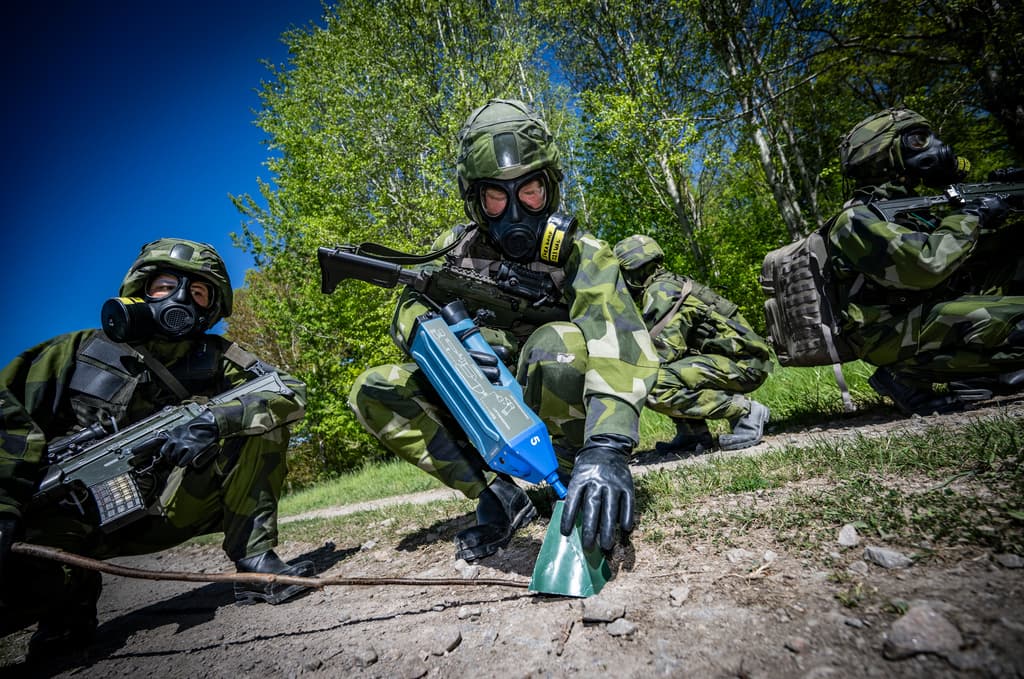In NATO's policy, it is clear that member countries should strengthen their protection against chemical, biological, and nuclear threats. Despite this, the threats are only mentioned in passing in the Defense Committee's final report.
In Sweden, a single company is the spearhead in the defense against weapons of mass destruction.
The sun beats down over the training area in Karlskrona. Behind masks and in full protective gear, four conscripts are struggling in and out of a truck. It's the final exercise, and the soldiers have been tasked with sanitizing a road. In the front, four nozzles are mounted, designed to spray out agents that neutralize deadly nerve gas.
The optimal weather for working is around five degrees with the equipment we have. And now it's almost twenty degrees warm, says Knut Drevhammar, 20-year-old conscript from Östersund, and adds:
You just have to grit your teeth and think good thoughts.
He is one of the soldiers being trained at the CBRN company at the Total Defense Protection Center in Umeå. The acronym may sound undramatic, but it stands for chemical, biological, radiological, and nuclear threats, simply put, weapons of mass destruction.
According to NATO, the threat is "ongoing and developing" and the alliance should continue to strengthen its defense against it.
"Not very comfortable"
NATO points out Russia as the main threat. According to the Total Defense Research Institute (FOI), tear gas has likely been used in Ukraine, in violation of the Chemical Weapons Convention. Russia has also been accused of poisoning former spy Sergei Skripal in England in 2018, as well as Russian opposition politician Alexei Navalny in 2020.
Besides Russia, terrorists, China, North Korea, and Syria are mentioned as potential CBRN threats to the alliance.
Part of the complexity lies in the fact that the boundaries are both shifting and blurring. New substances are emerging. There is a constant development in this area, says Jan Demarkesse, colonel and deputy for strategic planning in the defense staff.
It's clear that we need to follow this very closely and be able to keep up with what's happening, he continues.
He was previously the head of the Protection Center in Umeå, where the CBRN company is located, and has seen the threat change. They were simply too few.
We didn't have any volumes. You had to prioritize all the time, he says about the view during the 2010s.
But Russia's illegal annexation of Crimea in 2014 and the full-scale invasion of Ukraine in 2022 have changed everything. In Sweden, conscription was reintroduced after being dormant for several years.
This year's conscript cohort at the CBRN company in Umeå will be deployed at the Örlogsbasen in Karlskrona. By rotating the cohorts, the idea is that all branches of the military will eventually get the competence. This year's final exercise is therefore taking place together with the navy.
It will be a more specialized type of sanitation of ships, boats, harbors, and quays. It's something we're not very used to up in Umeå, but something we need to solve down here, says Klara Ögärd, conscript from Gothenburg.
Larger cohorts
78 conscripts enlisted last year at the CBRN company. This year's cohort will be 110.
We're building larger volumes. It's similar to what we had in the 1980s and 1990s, says Peter Nilsson, head of the conscript company.
All Swedish units should have a basic capability to take care of themselves and protect themselves against chemical, biological, and nuclear threats. What the CBRN company can do is more specific tasks, such as sanitizing vehicles or contaminated areas.
The general unit can't do that. And we can also test and find out what the hell the opponent has used, says Nilsson.
At the Total Defense Protection Center in Umeå, there are two mobile laboratories. Here, civilian experts can identify warfare agents from samples taken by the company in the field. During the pandemic, the laboratory was used to analyze coronavirus tests. Personnel and conscripts also set up a temporary CBRN staff at the Public Health Agency's premises, where they helped with testing.
But despite the risks and NATO's policy, CBRN is only mentioned in passing in the Defense Committee's recently presented final report. However, Jan Demarkesse at the defense staff doesn't think that means they're not investing in the area.
I perceive it as we're making a material investment now, we're making an educational investment, and this is included as a natural part of our exercises, he says.
Getting better
Peter Nilsson diplomatically states that you always want more, but he also feels that the area is being prioritized within the Defense Forces.
With larger conscript cohorts, and eventually with repetition exercises, the competence will slowly but surely grow. The same applies to the material. The Defense Materiel Administration describes the budget as increasing. New breathing protection, underwear, and protective suits have been ordered. More sanitation systems are coming, as well as modern sensors. Drones that can detect hazardous substances from above may be the next big step.
We've placed orders for a long time ahead. And it's significant deliveries that we're waiting for, says Peter Nilsson.
Maja Ernolf from Stockholm describes her conscript time at the company as "better than I ever could have imagined".
I think it feels so extremely important that you put more time and more effort into actually teaching these things, considering that it can lead to extreme consequences, she says.
CBRN is an abbreviation for chemical, biological, radiological, and nuclear threats and risks. CBRN was previously called ABC or NBC, and the abbreviation is used both militarily and civically.
Chemical weapons contain substances that kill or harm through poisoning. Sarin and the nerve agent novichok are examples of chemical weapons.
Biological weapons are bacteria, viruses, fungi, or toxins intended to spread disease.
Radiological substances emit radiation that can cause direct damage (such as burns) or indirect health effects (such as cancer).
Nuclear substances can undergo nuclear fission, releasing large amounts of energy and forming radioactive substances.
Source: The Defense Forces, MSB, FOI






